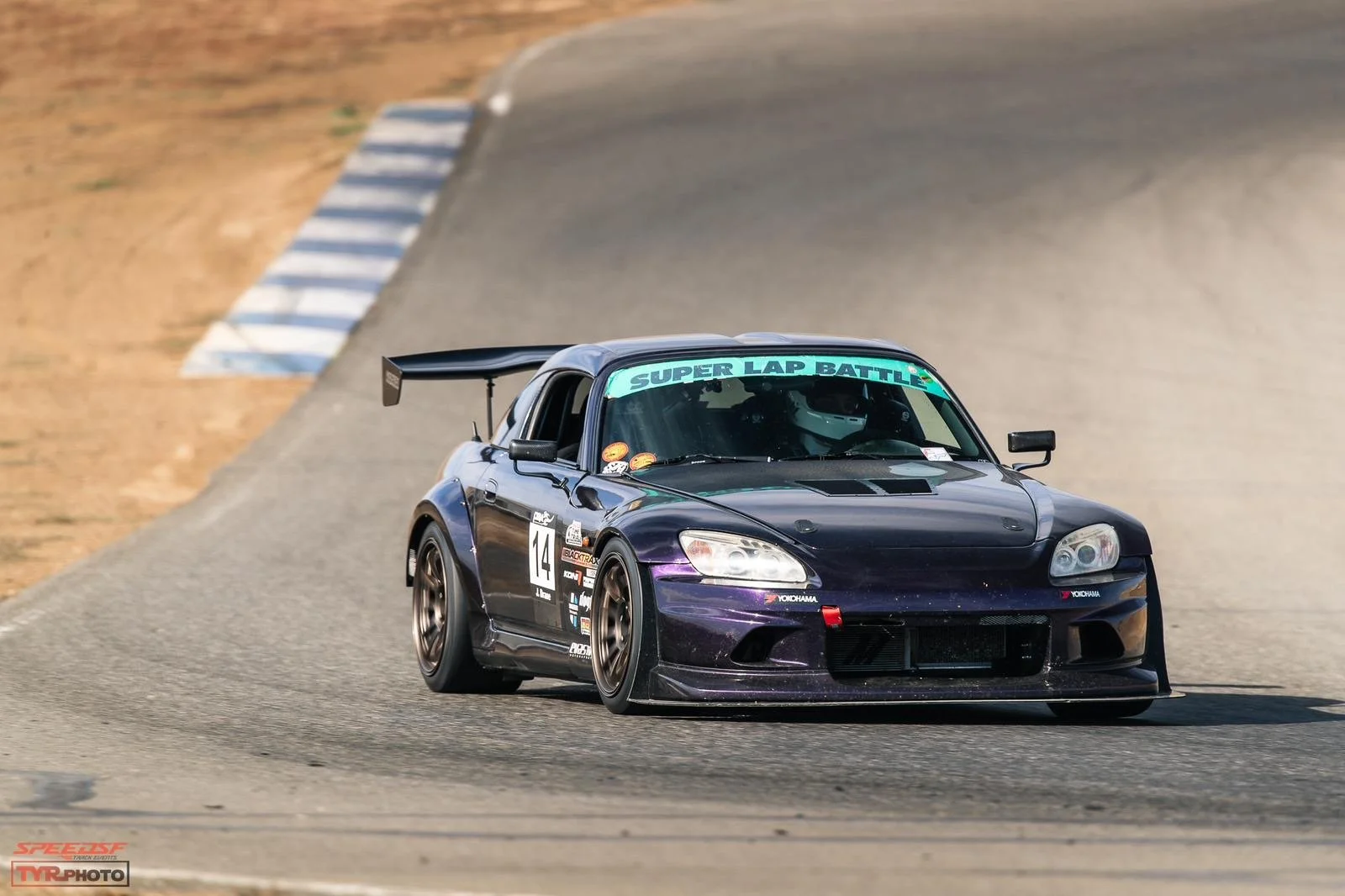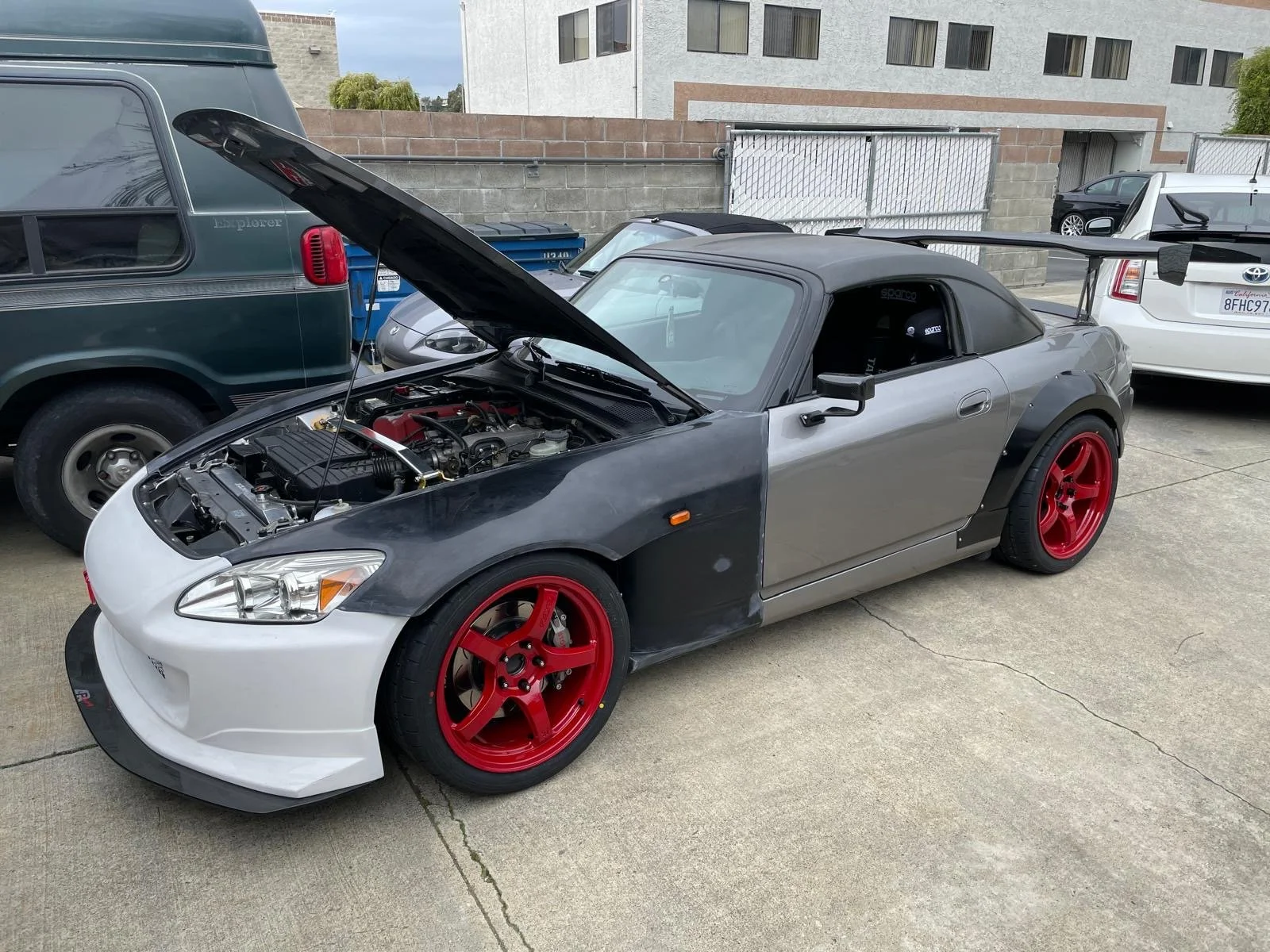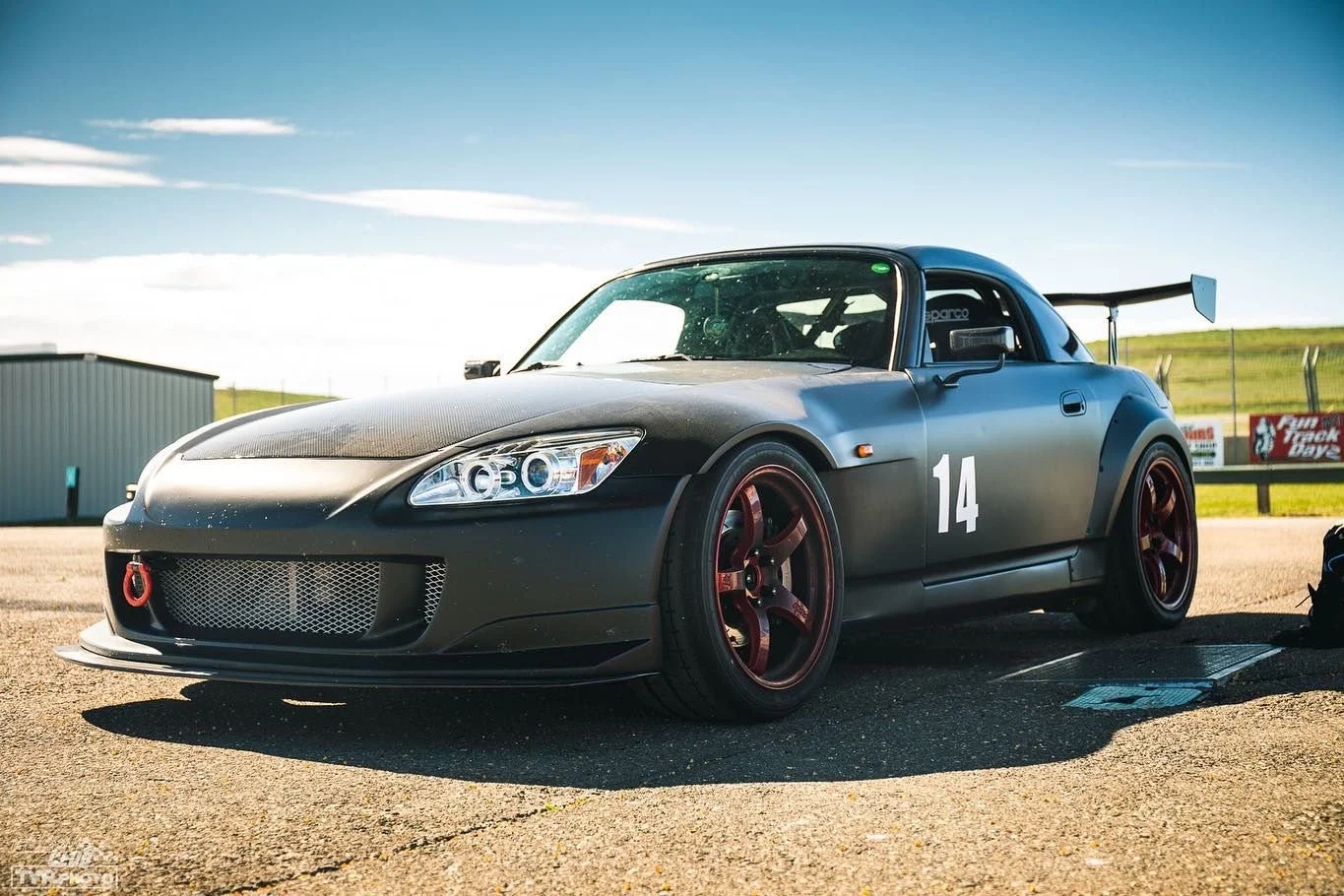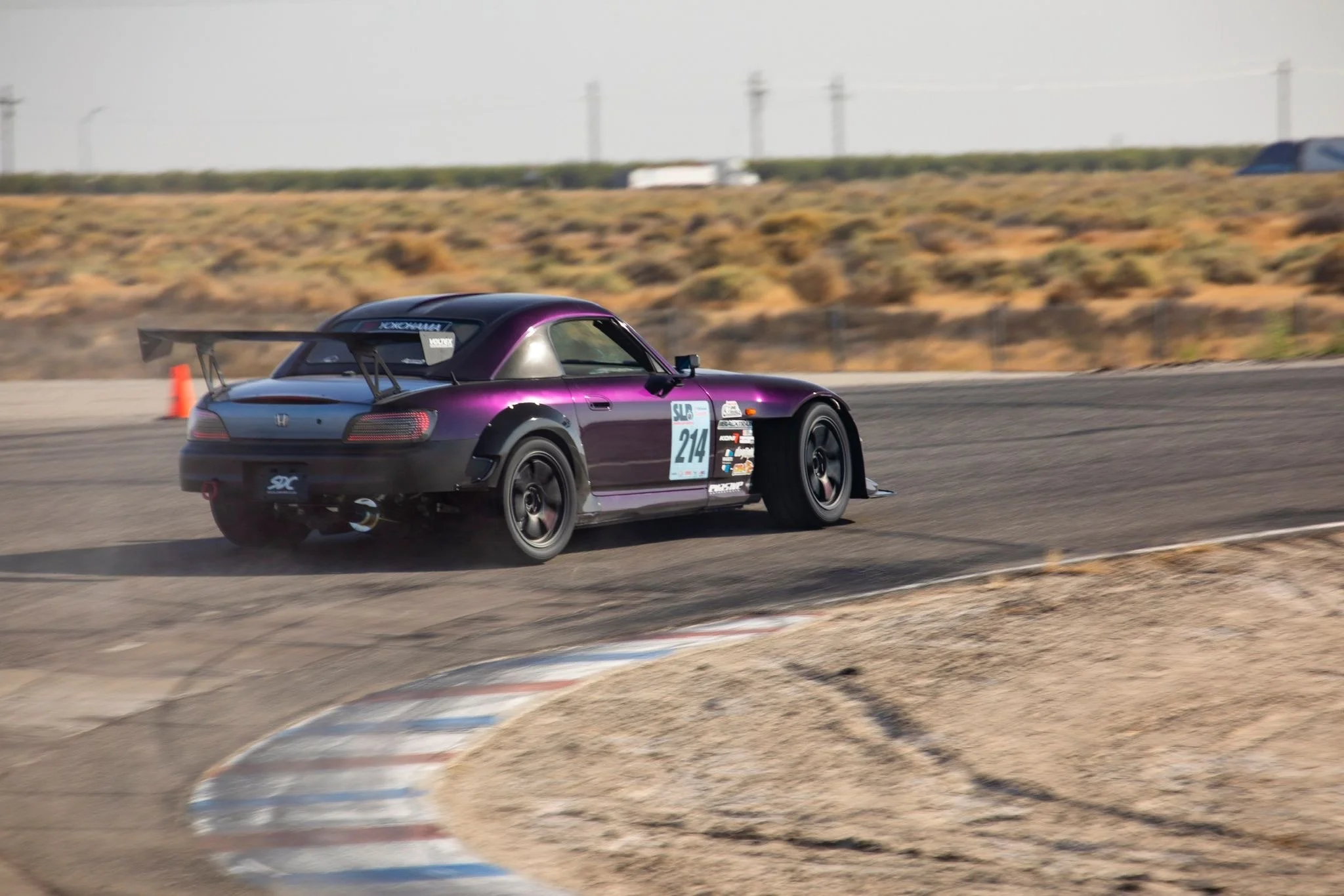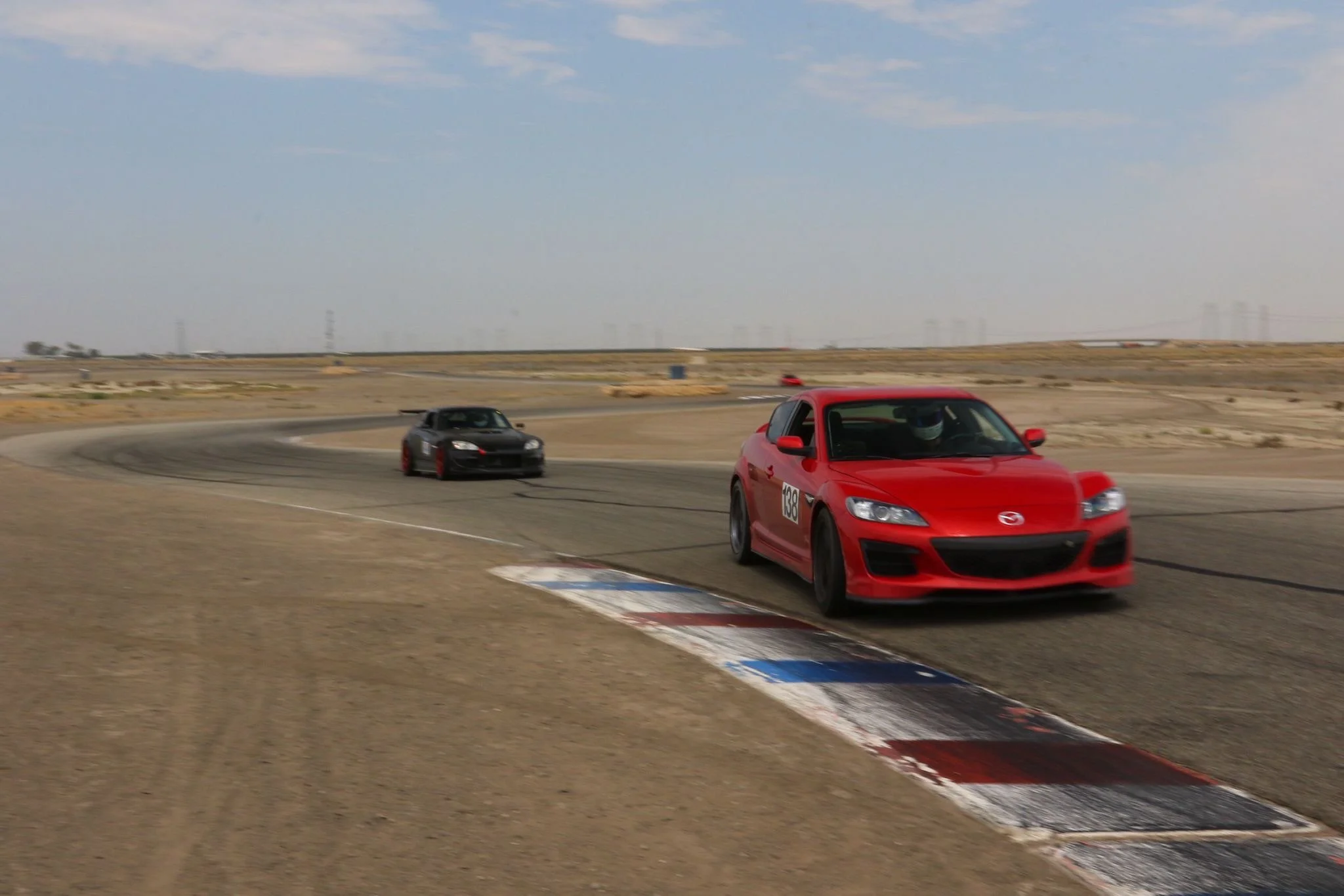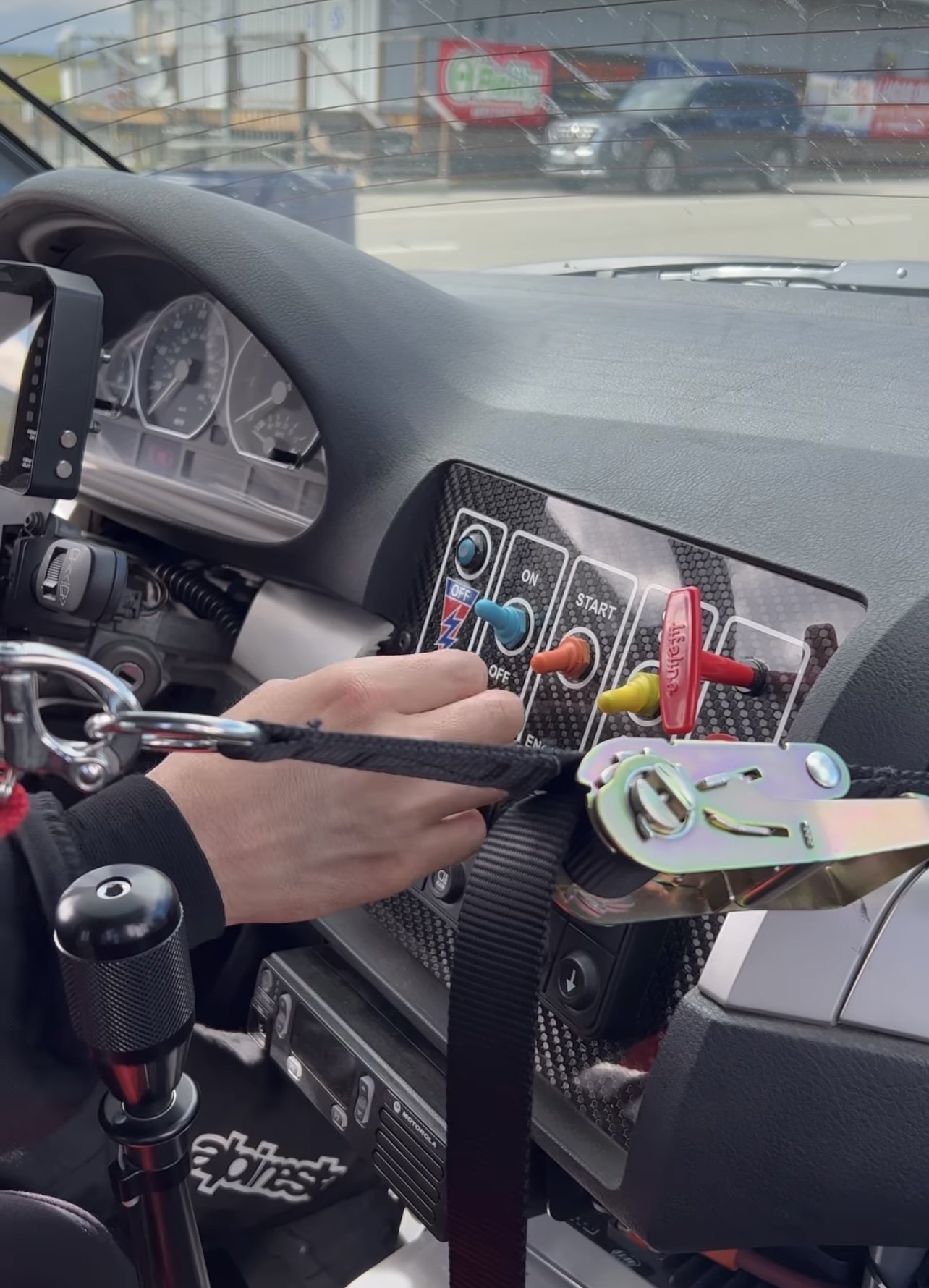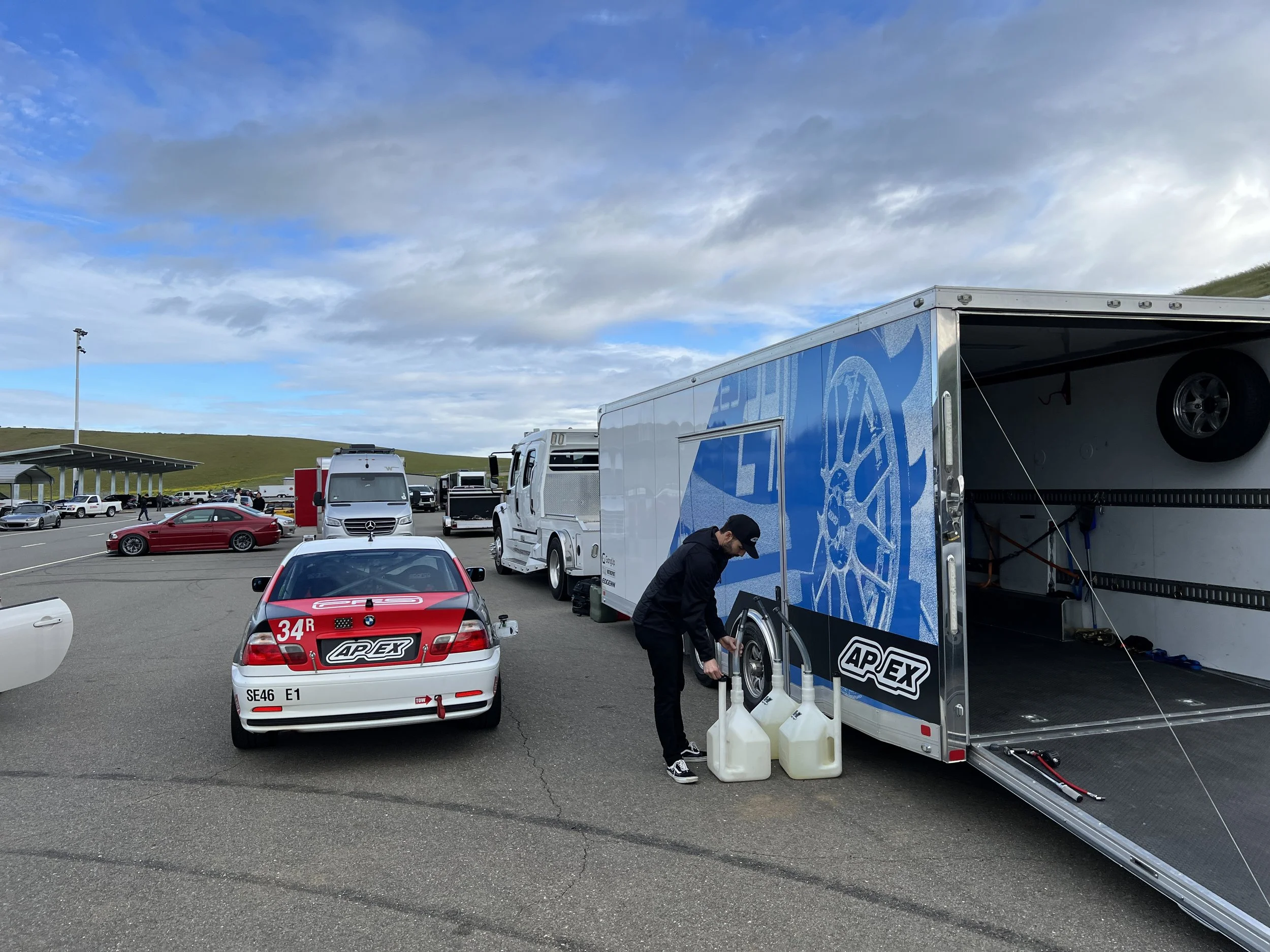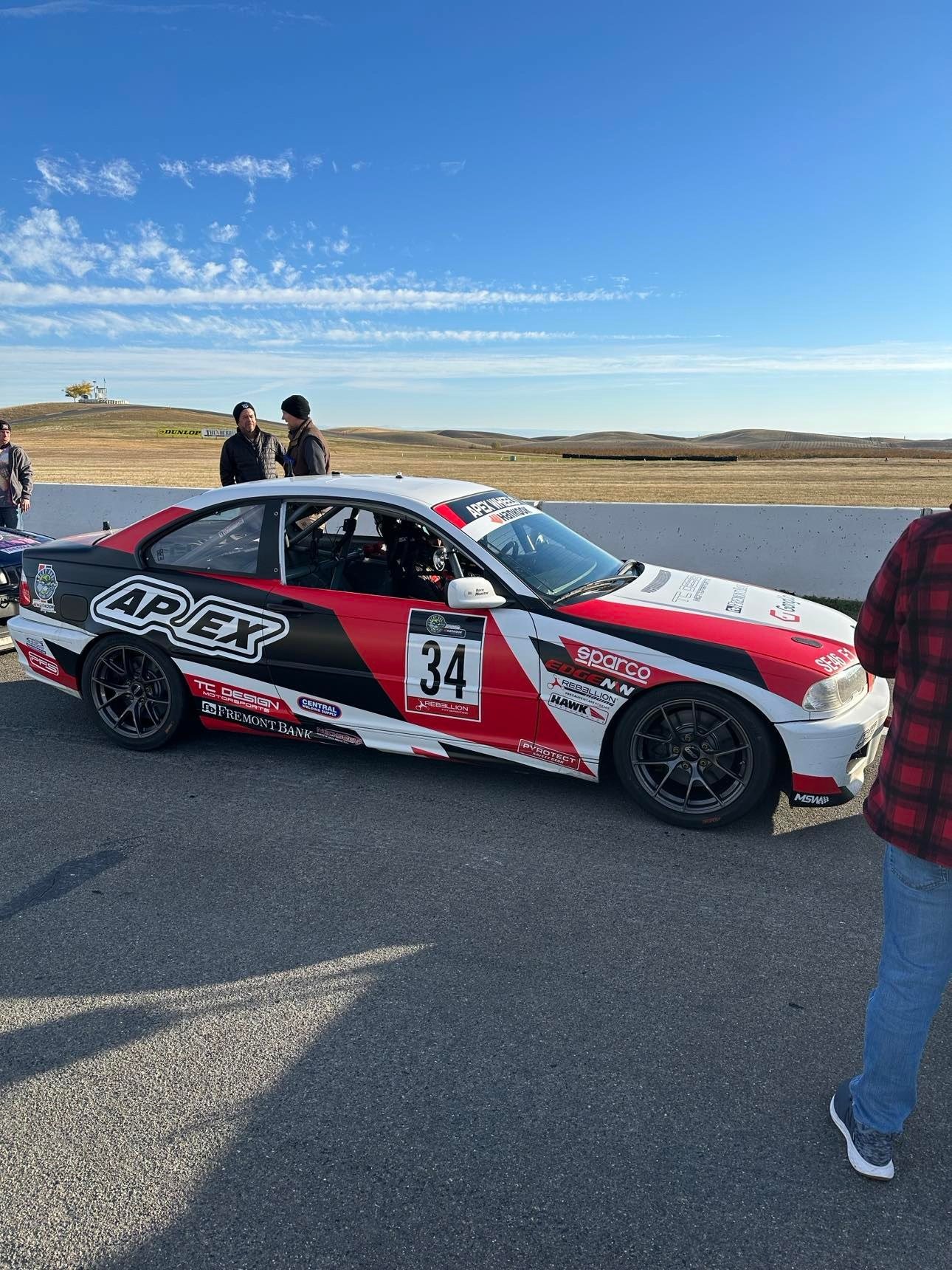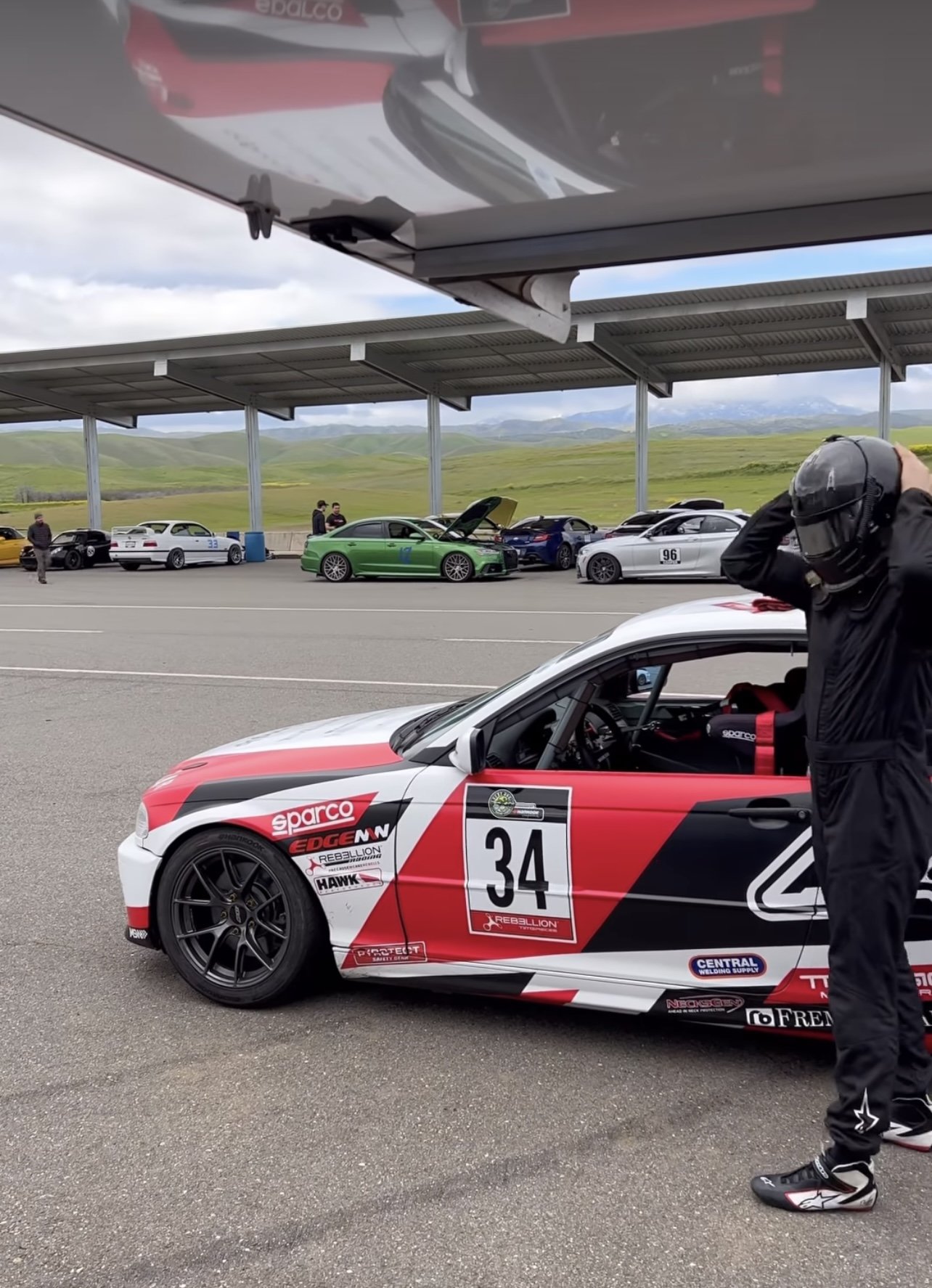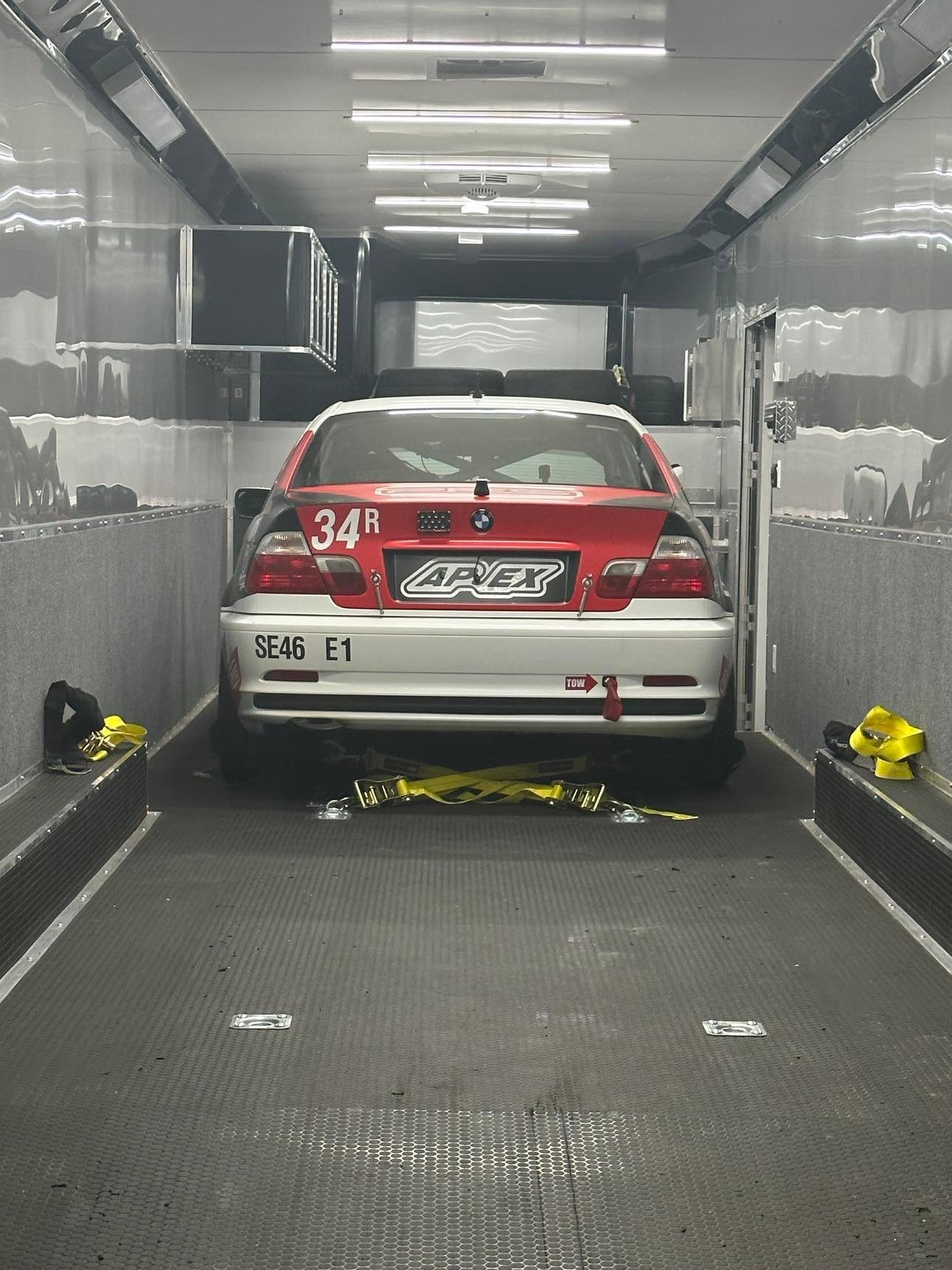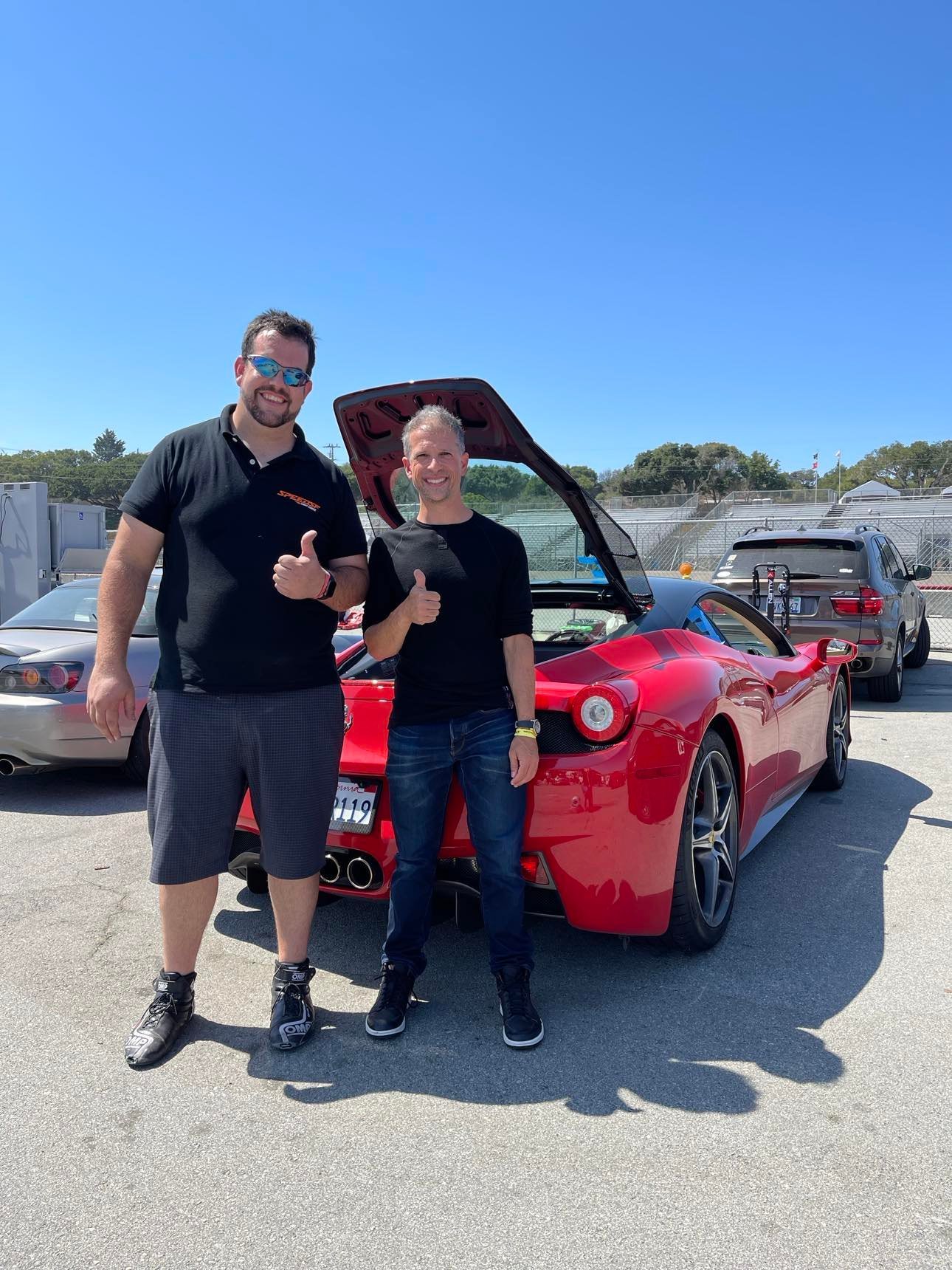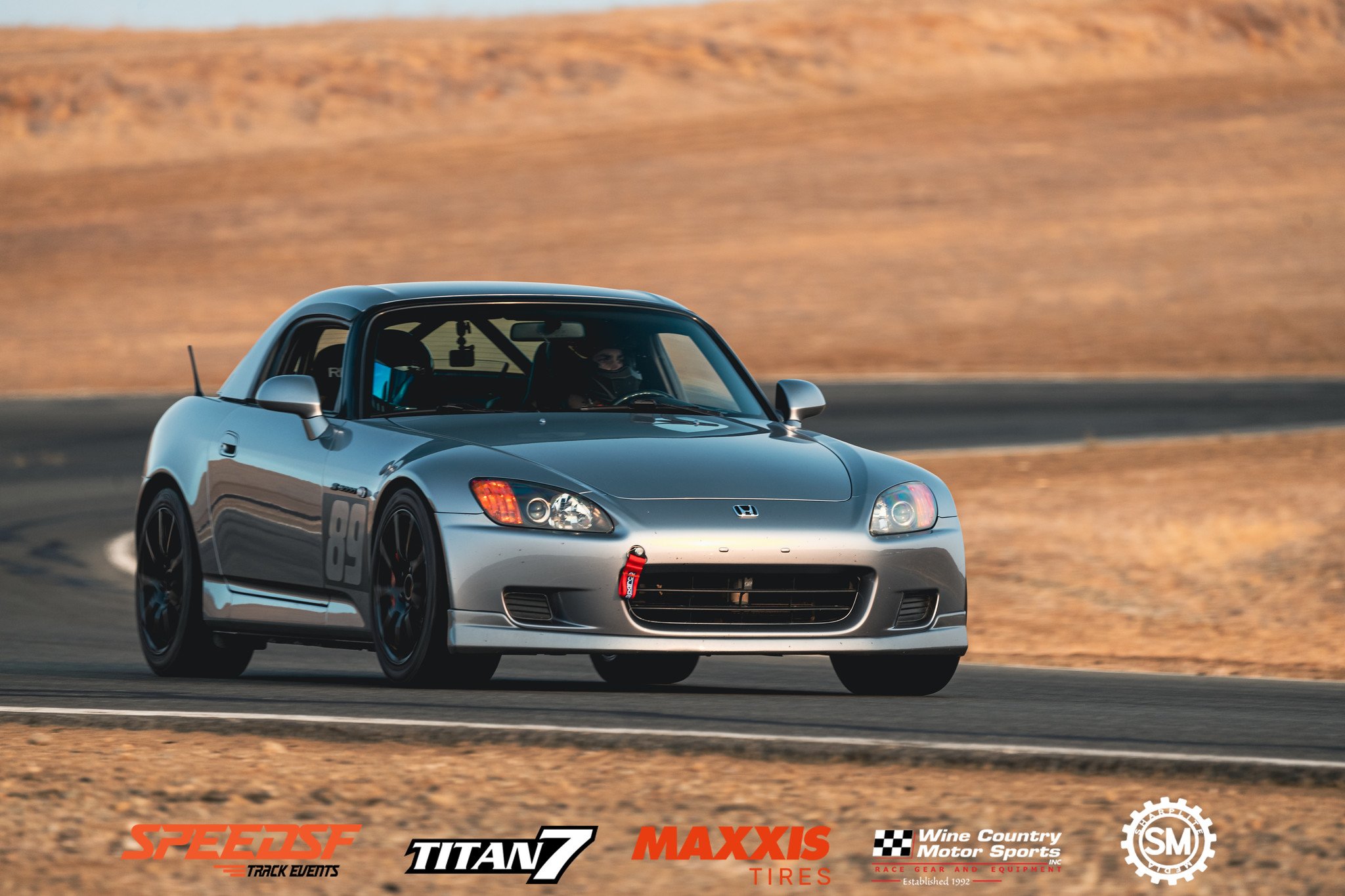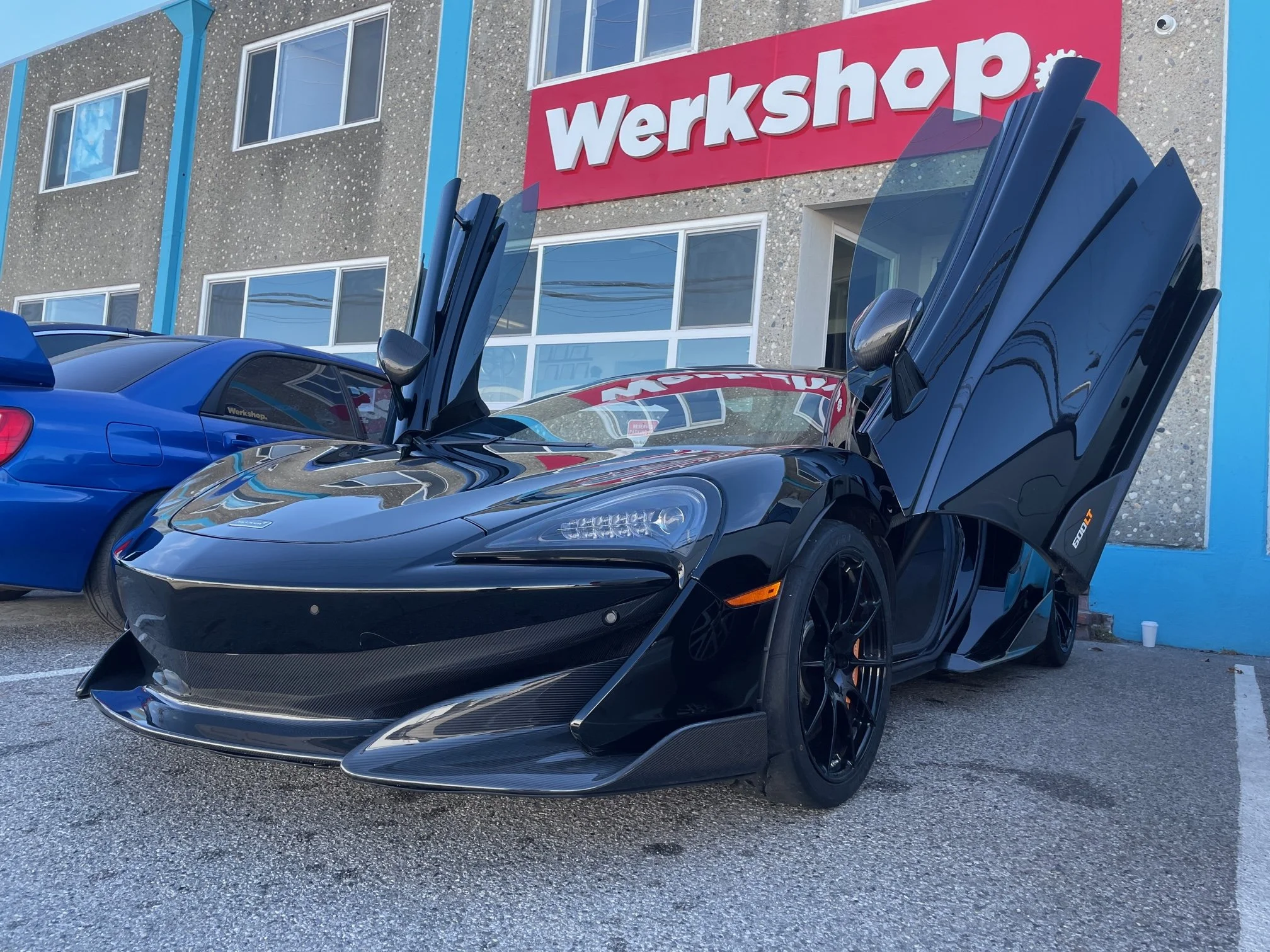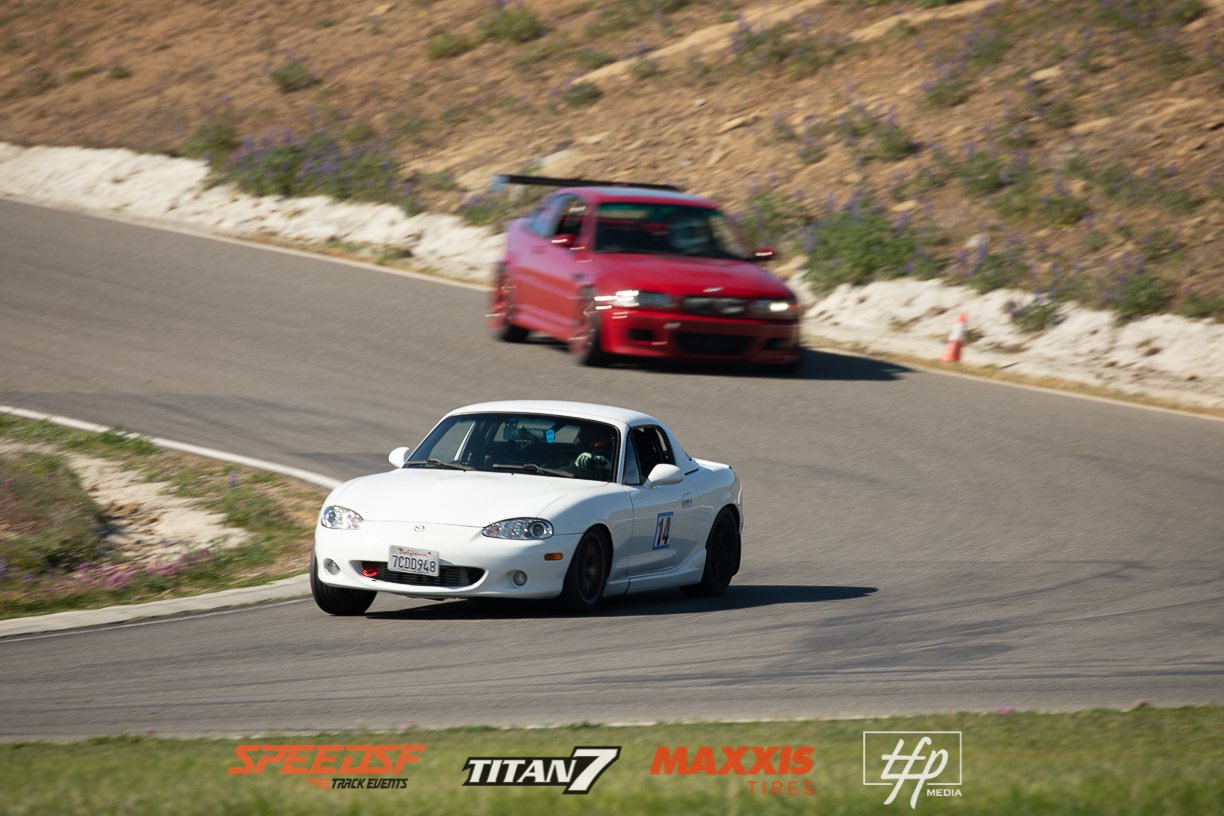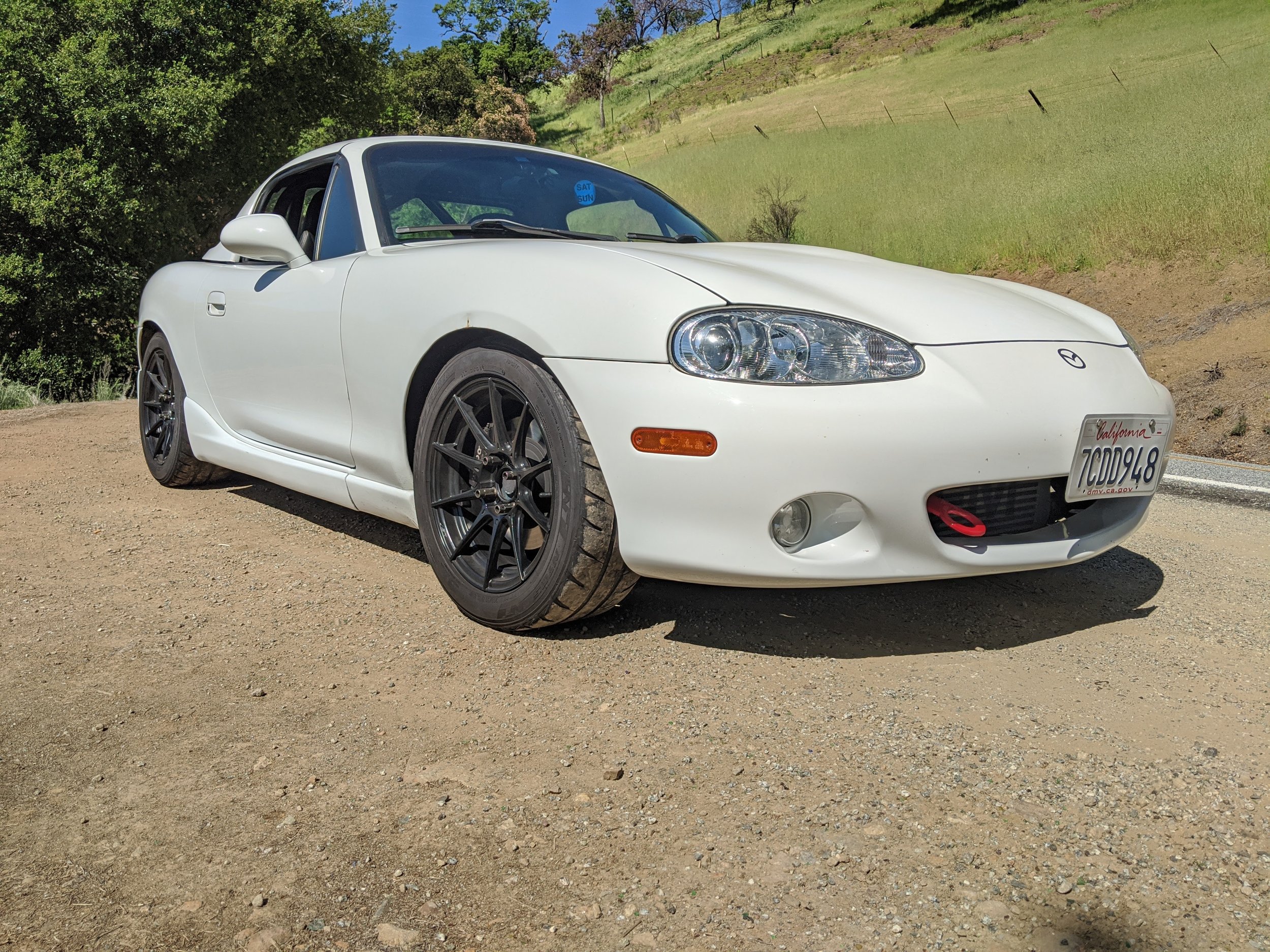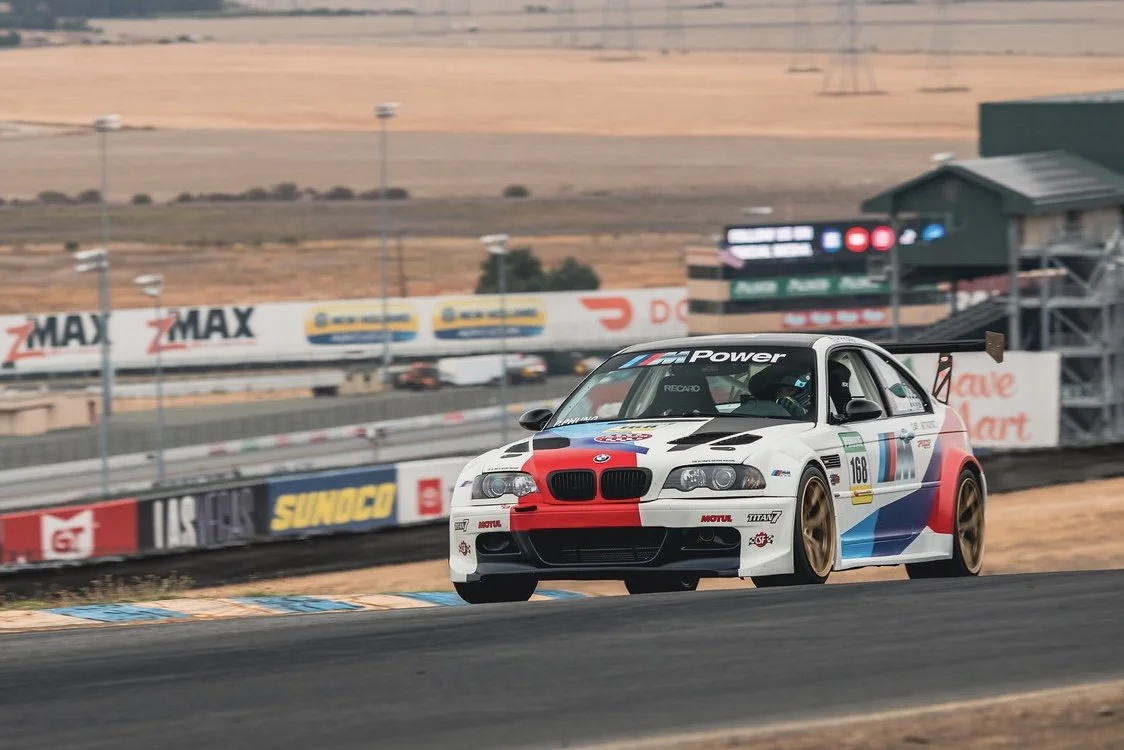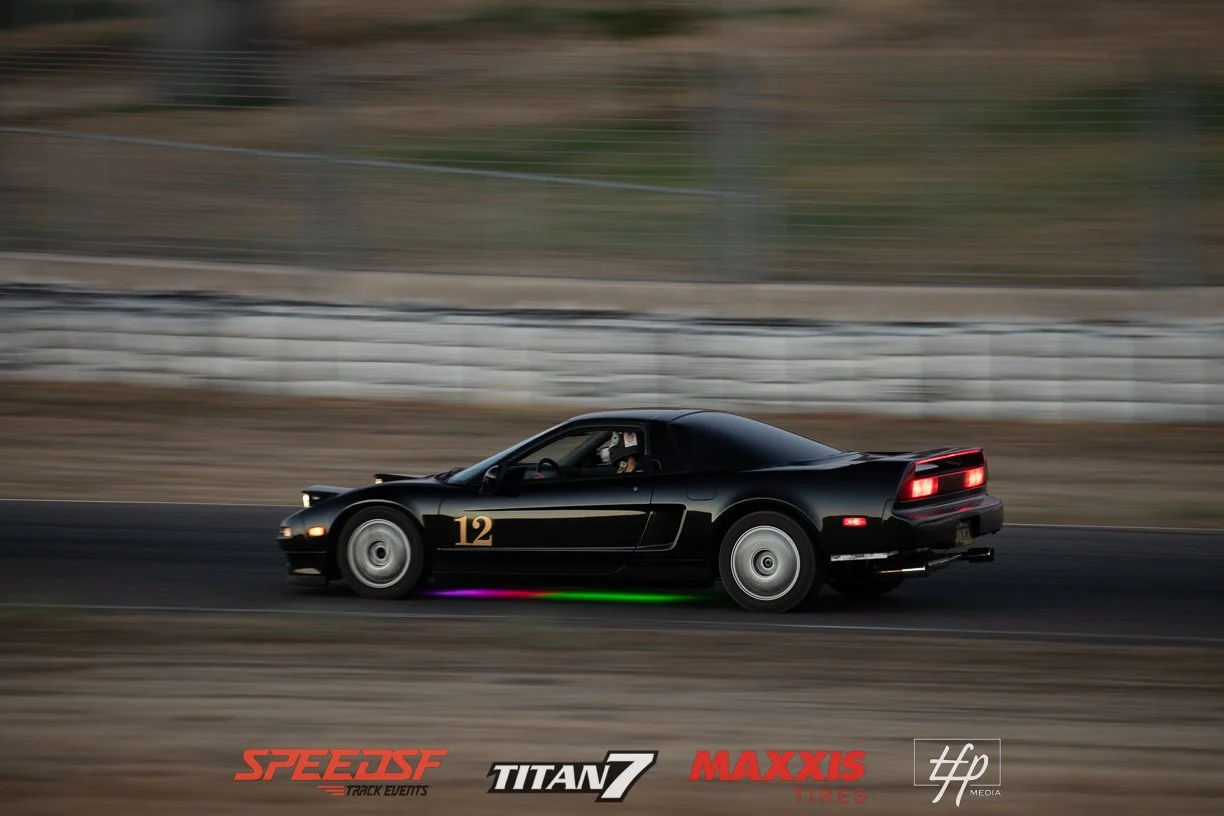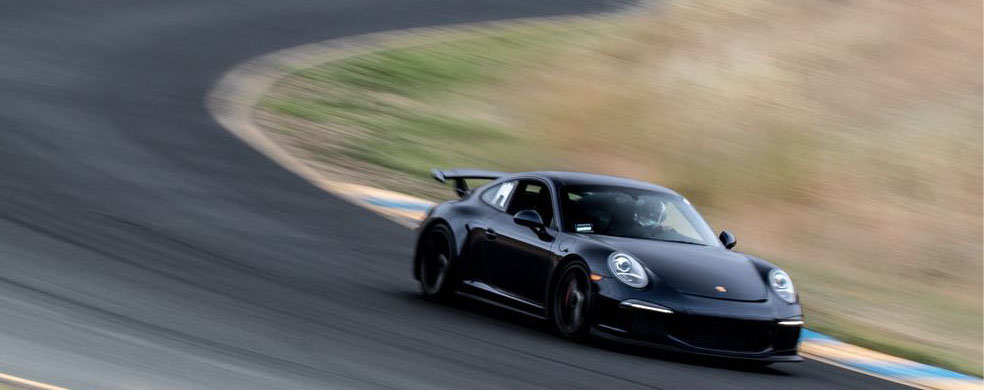
Joe’s AP1 S2000: Continuing Education
A couple years before forty, Joe Drane decided to finally give track days a try. Like with everything he’s pursued, he dove in with two feet and built a stunning S2000 in record time.
It wasn’t until Joe Drane moved out to California at the ripe age of 38 that he was able to try track driving for himself. Being a natural tinkerer and a bit of a hot rodder growing up, track driving had been a lifelong dream, but the opportunities for that sort of thing in rural Florida were few and far between.
After teaching him the ins and outs of network engineering, Joe started learning the cloud and found a few roles with startups in Texas. This created a focus on execution and continuous learning while also placing high value in data helped him put together a stellar resume in short time. This almost obsessive approach would later help Joe learn at a ridiculously rapid rate when learning the racing ropes.
The Land of Milk and Honey
After relocating to San Francisco to start a new role with Facebook, the assortment of beautiful sports cars lining the streets suggested he might be in the right place to learn to drive on track. He searched for ins on the pages of the local sanctioning bodies until he found an easier, more cost-effective way to dip his toe in the water.
Meanwhile, the need for a new outlet was getting harder to ignore. COVID weighed heavily on him, and while he loved his new job, it didn’t offer the distraction he needed mid-pandemic.
When he proposed running a few lapping days one weekend, his wife not only supported him in his decision, she helped him find an appropriate track car. Incidentally, the two had met at work after Joe spotted her leaving her S2000 in the parking lot. It only seemed right that such a car, the conversation starter, would help him start another love affair.
And so he picked out the cheapest first-gen S2000 he could find. This was several years ago, but even by the standards of the time, this car was affordable — and for good reason. “It was just a mess. It had no rear glass, the check engine light was on, the wiring was a rat’s nest, and the motor was ticking. I spent the winter restoring it, but I didn’t realize just how bad things were until I started working on it.”
Growing Pains
“I ran into some issues installing the aftermarket parts. The radiator wasn’t sitting low enough for the hood to close. I took it into the shop at BlackTrax to have it inspected, and there the mess continued to unfold. The radiator supports were bent, and I couldn’t purchase new ones anymore. I had to source the brackets from two fender cutouts from eBay.
Then we pulled the cylinder head and saw the valve retainers were cracked, there was a ton of carbon on the valves, and two of the cylinder walls were scarred. After ten track days, the transmission blew third gear. Oh man, what a nightmare it was.”
To mend the ailing engine and fortify it for track use, he replaced the block with rebuilt F22’s, then fitted a Radium catch can as well as Mishimoto’s radiator and oil cooler. Not eager to deal with another blown F-series, he wisely spent a few thousand more on a Link G4+ ECU to employ several failsafes and extract everything from the motor — mainly more mid-range torque and a peak of 227 horsepower at the wheels.The Link was then paired to an AiM MXG dash which to give him alerts and relay lap data.
Despite the early hurdles he had to cover, he remained willing and able to push on. The obsessive drive which fueled Joe’s career now had a second outlet; allowing him to research the engineering involved, pick parts, test them on track, and build a more supportive social network than the one which work provided him.
As it gave him a new lease on life, he didn’t hesitate to spend whatever was needed to turn this rough example of an S2000 into something exceptional. Within a few months, he’d added a long list of modifications to try and breathe some new life into this aging chassis.
After investing so much in the performance side of things, it made sense to apply an Inozetek wrap to help the car pop.
Among those additions were an APR splitter, a Voltex Type II wing, Rockstar Garage’s Feal two-way coilovers, and Stoptech C43 (F) and C42 big (R) brakes. Studying hours of onboard footage — namely Nate Hackman’s banzai laps — helped him understand just how much harder he could apply the brakes and how severely late he was getting to throttle.
In the interest of getting up to speed quickly, he skipped the cheap tires and went straight to a set of Yokohama Advan A052s, then wrapped them around a set of 18 x 9.5” Advan Gram Lights.
Though he’d already spent a small fortune on parts, never once did Joe agonize over expense during this introductory period. “I decided to pay for an education in racing since I feel it usually pays dividends,” he said. When his engine tuner Jei from BlackTrax offered to tag along to one HPDE at Thunderhill and teach Joe to study data, he jumped at the opportunity. “The telemetry revealed I was shifting a little too much, so we figured out the right shift points and instantly cut a couple seconds off my PB.”
The car was capable and reassuring enough for Joe to continue pushing, but asking more the car led to the standard Torsen differential failing. In its place, Joe put a Puddymod 1.5-way OSG and found the incremental improvement in power-down and stability motivating enough to invest in one other area that wasn’t quite up to snuff: dampers.
Joe knew the top-shelf option would make the car more quicker, more predictable, and less taxing to drive, so he splurged on a set of Blacktrax-built Penske 8300s. Even without much knob turning, the new dampers revitalized the car and helped Joe find the confidence to commit to the quick corners. “My favorite mod, without question. I dropped six seconds off my previous best the first time out on the Penskes. Worth every penny.”
Continuing Education
Learning to wrench and approach the track from a theoretical perspective helped him progress, but never having attended a racing school, he started to wonder if there were ways to improve his technique post-haste. He enrolled in a few drift courses to study the art of oversteering, and soon felt at ease asking the S2000 to rotate a little more than before.
Both his approach and the S2000’s setup are far from perfect, and Joe’s wise enough to admit that. “I haven’t thought much about adjusting the dampers — most of the time I just leave them in a neutral position and try to drive as best as I can.”
But the results from a relatively short time spent on track speak for themselves. He’s learned at a remarkable rate and, with a little more guidance from the knowledgeable group of friends he’s made recently, he’s bound to be fighting for podiums at the front of the S3 class sometime soon. He still has a few points to play with — and they’ll go towards a Zebulon rear wing, a larger Alumalite splitter, and Professional Awesome tunnels.
Joe’s studious nature has also helped him better understand the endless tradeoffs that building a track car requires. While the major cost associated with getting a rough car off the ground can eat into an aspiring driver’s budget, the peace of mind that comes from driving a flawed, imperfect car can help a driver push hard — harder than they likely would in a pristine example. That’s why he has no regrets taking the rocky but fruitful and informative path he took.
Why Trackday Coaching Matters
When Eric Preciado got serious about his racing, he hired a driving coach to help him shed some of the bad habits he’d picked up in autocrossing. At the end of his first day with Joe McGuigan issuing instructions, Eric was lapping nearly five seconds faster than he had previously.
Although Eric Preciado had experience in a variety of cars in e-sports and some track time in the real world, he sensed he needed some guidance or, at the very least, some structured lessons to help him advance as a driver.
Being a fastidious and goal-oriented person who likes to monitor his progress in everything he does, Eric Preciado figured a coach would help him analyze and understand his driving technique a little better. He hired colleague and local ace Joe McGuigan to guide him along, and as Eric realized, a good coach can offer much more than basic lessons in theory and technique.
Laying a Foundation
Joe’s opinion as a professional instructor was that, as opposed to Eric’s Cayman or another unforgiving car, a Spec E46 would help Eric advance the fastest. Plus, it was a company car, so it was easy for Eric to borrow it for a day.
Spacious, forgiving, torquey, quick, and easy on consumables, it’s fast enough for most drivers and a great way for drivers to learn their craft comfortably. Because of its progressive breakaway, it gives a coach plenty of time to identify a mistake made by their student long before it happens.
With the proper car selected, they started their day at Thunderhill West going through some rudimentary theory. Joe’s basic approach is to help a novice build a foundation of good habits that will keep them safe, that they can continue to build upon, and that help explain the physics at play. With Eric, it began with a detailed explanation of the racing line, including braking and turn-in points.
Though Eric had a basic understanding of these concepts, he had developed some habits in autocrossing that do not transfer well into the world of road racing. “I didn’t recognize it, but I was shocking the car with really rapid steering inputs. This usually works in autocross, but not at higher speeds,” Eric recalled.
Then there were the braking points. Most initiates struggle to realize just how hard and late into the braking zone a well-sorted car can stop. It’s a forceful touch—easy enough to understand given some instruction—but the timing and the release of the pedal take far more sensitivity, and that’s something an experienced, sensitive driver can assist their pupil with.
Eric listened intently and put those pieces of information to good use. With his newfound confidence on the brakes and slightly cleaner lines, Eric set a baseline of 1:31—a respectable time at Thunderhill West and a full two seconds faster than he was able to go on his own previously.
As impressive as that drop in time was for only one session of work, Joe knew that he’d have to encourage Eric to push a little harder in order to find more time. To convince Eric that the car could take much more abuse, Joe took the wheel for two laps and demonstrated how late he could brake, how much entry speed he could carry, and how sane and composed it would be, despite all the additional loading. Even with two heavy occupants, Joe proved this well-sorted Spec E46 could lap Thunderhill West in 1:25.
This demonstration was not given without one firm reminder: this is what the car is capable of when it’s driven properly; going faster isn’t as much about courage as a novice might think. Muscle memory can be acquired from the passenger seat, and when Eric left it to get back behind the wheel, he had a few new things he wanted to try.
Following the First Leap
Now confident the car could brake later and carry much more entry speed than he thought was possible, the coach became vital. Now asking more from the car and making inputs which weren’t all that different from those he made earlier in the morning, the Spec E46 didn’t quite stick where it had before.
Resolving this oversteer issue began with the typical countersteer-pause-recovery process so many of us are familiar with, but need a little fine-tuning to make it second-nature. After a session on the skidpad, Eric felt comfortable catching his little slides. “Not only did I get an idea of what the limits were, but I learned how to deal with going over the limit. Rear end steps out? A nice and controlled throttle application with the appropriate amount of countersteer will solve that,” he noted.
It’s a recognition of the subtler mistakes that a student makes which makes a coach sitting onboard so valuable. Joe, seeing that Eric was lifting off the throttle for an extended period—a normal side effect of carrying more entry speed than is comfortable, and so he had to make a critique.
An example of a tailored to-do list for one of Joe’s clients.
“I could see that his long lift off the throttle was destabilizing the car, so I told Eric to start using a little maintenance throttle in Turn 6 to help settle the rear end,” Joe said. Not only was this to help his student progress safely, but to help Eric understand that a little oversteer is nothing to worry about—it can even be his ally in cornering. Talk about a shift in perspective.
Along with the softer steering inputs, more assertion with the brake inputs, and a careful weight transfer that helped give him confidence in the faster corners, Eric could start to feel comfortable enough to analyze his driving and use a little bit of rear rotation to help him corner faster. Prior to that, he was driving cautiously and dedicating most of his concentration to avoiding an oversteer moment.
To have both peace and presence of mind is worth the cost alone, but it’s hard to brag about those things at a bar with your buddies. Thankfully, Eric had a new stat he could hang his hat on: he managed to get down to a 1:28.2 by the end of his final session—that’s an improvement of nearly five seconds in just four sessions.
Solutions for the Time/Budget-Limited
Not everyone has the flexibility or the budget to arrange for in-person coaching, but those shouldn’t prevent them from getting a qualified professional’s perspective. Fortunately, there are two ways drivers can get some instruction from the comfort of their homes at a time that is convenient for both student and instructor.
“Video reviews are something I enjoy doing as they allow me to give relatively quick and easy to digest notes for a new client to understand, while giving me a sneak preview of their habits—both good and bad—that I can use for our future in-car coaching sessions.
I also do this with some of my regular clients as well, as timing doesn’t always work out for me to do in-car coaching. Obviously, driving a track I am familiar with helps, but I can still provide notes even for a track I haven’t necessarily driven in real life, but I can still give input on basic lines and inputs the driver is doing with the car. However, there is another form of digital coaching that I utilize, which even allows me to do lead follow, and that is sim coaching.
I prefer working with Assetto Corsa as the track and car availability is very vast thanks to an active modding community. The joys of doing sim racing is that I can be live chatting with a client while watching the live feed via Discord or other streaming service. We can even do lead-follow together, practice passing and defending, and walk through setup changes to improve the car that client's driving,” Joe elaborates.
Undebatable Data
For the advanced driver, it’s data review that makes the difference. The difference between an exceptional lap and a good lap is almost imperceptible, even to the trained eye. Studying data, as is possible with the information collected by an AIM SOLO or similar device allows them to get into the nitty gritty. Ideally, they run a demo lap with Joe driving, then overlay the clients lap and work on the low hanging fruit before focusing on those last couple tenths of a second.
This sort of review will help you recognize that, for instance, braking later into a corner followed by a long straight will not always yield the best overall time. Though theory claims that you should prioritize the exit in a corner leading onto a straightaway, the top speeds and delta shown in the data reveal just how much a banzai-braking attempt is actually paying off. Unlearning bad habits is made easier when the student is presented with irrefutable evidence of their detrimental effects.
Experience Reducing Energy Expended
Though it’s mostly changes in technique that aid the novice driver the most, the intermediate and advanced drivers can benefit from a coach’s understanding of a particular car and what it needs in terms of chassis set up.
The E46 was set up for sticky Hoosiers, but because they’d fitted it with milder RS4s that day, Joe made a few tweaks to the MCS 1-way coilovers after his session; softening the bump and rebound to suit the level of grip offered by the RS4s.
Breaking Past Imaginary Barriers
“While I understand the physics and vehicle dynamics behind driving at the limit, I didn’t know them physically. My perception of what the limit was has always been flawed and defined by other imaginary circumstances such as wrecking a car or not being able to afford replacing a bent tie rod.
Coaching allows you to understand where the limits really are, how they feel like, and how to drive near or past them. With Joe, I was put in a position to experience those things safely, which gave me the confidence to push past my own mental blocks holding me back from becoming a better driver,” said Eric.
While some might think the extra expense is unnecessary, nothing—not better parts, not better weather, not even weight reduction—will make as big a difference to lap time in one day of driving. Frankly, the pride that comes in figuring things out for yourself is not worth the time and expense—and those discoveries are harder to make as the driving level improves and glaring mistakes become subtle imperfections. Bank on a coach with a good reputation and your bank account will thank you for it.
For more on Joe’s coaching services, visit Average Joe’s Coaching.
Alex's AP1 S2000: Earning His Spurs
Tempted to try something livelier than his DC1, Alex bought himself an AP1 S2000 a few years back and learned how lively it really was. He chose his modifications with the aim of making it reliable and predictable, and in doing so, built a foundation upon which he could learn his craft.
Though this AP1 wasn’t Alex Caruso’s first track car, it was the car with which he truly earned his spurs. A few years before buying this car, he got his feet wet with an NA Miata, then later an Integra GSR. Thesef two taught him about car control and patience with the right foot, but they lost their appeal with time. Eventually, he wanted to try something a bit more exhilarating. By then, Alex was no longer a student just scraping by, and he had a little more to spend on a special sort of car.
When this car popped up in his feed, he immediately checked his bank balance. Hardtop, great paint, totally stock, and basically a blank slate with which he could express his creative streak. There was one problem, though: he couldn’t quite afford it. Undeterred, Alex committed to finding the money. With the help of his supportive wife, he scraped together enough for a down payment and brought it home.
Not long after, he started leafing through those old lists of dream parts he’d scrawled away when he was a daydreaming, broke college kid. The first round of mods were intended to make the motor indestructible. Because the ‘01 models didn’t receive the piston-cooling oil squirters the following year’s motor did, he retrofitted those to fit his motor, careful not to crossthread anything down there. Following that, he added AP2 valve retainers, then sent his valve covers out to be drilled; the AP1’s valve covers need to be perforated to help move some of the blowby.
Though these drilled valve covers works with the stock PCV system, Alex added a catch can—one which doesn’t need emptying until the fifth track day.
With the powertrain bulletproofed, he started running his car to the 9,000-rpm redline and enjoying the honeymoon phase, spins and all. The AP1’s nervousness was thrilling, challenging, and hugely educational—even if he had to clean plenty of grass out of his wheel wells. “Once I started pushing, I looped that thing so many times,” he laughed.
Though AP1’s dynamic toe curve kept him busy and certainly accelerated his steering corrections, he felt it prevented him from totally trusting the rear. “It almost felt like the rear was taking two sets in every corner,” he explained. In an attempt to get closer to his car and predict its movements better, he started with the second round of improvements.
Wisely, Alex went for a full set of Blacktrax sphericals, Hard Race motor mounts, and solid LSD collars. The added responsiveness and transparency of the car grew in proportion to his confidence. However, there was one glaring shortcoming he still hadn’t addressed.
That pesky toe curve could only be truly changed by swapping out the old AP1 subframe for an AP2 subframe. The first weekend out, the car was predictable and encouraging in a way Alex had never felt before, and so the second honeymoon phase began.
Never once in his four-year relationship with the car has he felt bored with the car, but he has always wondered if the wear items would let him down. To give him peace of mind, he reinforced the flimsy spot where the front upper control arm connects with the chassis. While at it, he swapped all four hubs out for Karcepts items and rid himself of another potential nightmare.
Finally, after a year of tracking his stout and predictable AP1, he started searching for more speed. The first round of go-fast goodies consisted of Sake Bomb Garage’s brake kit, a set of JRZ RS Pros, and a few engine bolt-ons—the last chosen mainly for noise.
“The coilovers really transformed the way the car handles over rough or uneven pavement. I knew the stock suspension was already well-tuned by Honda, so I didn't want to skimp on coilovers that would ruin the handling characteristics the Honda engineers worked so hard to develop. After popping my right rear upper ball joint out of its control arm coming at Laguna Seca, I knew wanted to get something that could control the chassis better without bottoming out as frequently or harshly.
I happened to make a connection with a JRZ vendor and scored a deal on a set of RS Pros. Now, not only is weight transfer much more immediate, I don't have a second thought about the car unsettling over bumps, like the Dorito at Thunderhill West. Having two-way adjustable coilovers also opens up a whole new world of suspension tuning that I'm slowly learning about. The ability to adjust the handling balance at the track and the peace of mind that the dampers will soak up any bumps I throw at them make these coilovers worth their weight in gold.”
The focus on the foundation, the time spent learning an imperfect car, and the carefully chosen selection of performance modifications all paid off in the first session following. Running on the same set of Hankook RS4s he’d used the time before, he dropped his times at Thunderhill West by two seconds.
There’s not much more this dependable car needs. It’s lively, reassuring, and while it’s not the punchiest car in the field, it is one of the most agile. Because he prioritized predictability and transparency over any other performance trait, he might opt for an aftermarket differential—Seigo Ma’s shown him how important they are. Maybe a little aero in there for good measure, but beyond that, all he needs is good weather and the time to spend with his second love.
“With how much I’d dreamed about this car before buying it, I was worried that I would be disappointed with the S2000, but I can safely say it's lived up to all of my expectations and then some. It's been rewarding to work on, to fix, to push myself with, and it's the exact tool I needed to get comfortable on track.”
Werkshop's Paint Protection Film Keeps Track Cars Sparkling
With Werkshop’s PPF, you can spend a few shekels to keep your car looking sexy. Full-body, front end-only, bumpers, basic cars, and even exotics are covered.
Oil, rubber, dirt, and miscellaneous debris can quickly wear down your car’s coat, and not everyone is thrilled with the patina of a well-used track missile.
Track Car Tarnish
Nate bought his S2000 in showroom condition, then promptly pockmarked his bumper through a couple years of autocrossing. When he tried to scrub the conerash off, his cloth started taking paint along with it. That scared him from attempting any real fix.
He held off on solving the issue until a year later, when the front bumper was now sandblasted from running in close confines with messy cars at Speed SF track events.
After respraying his bumper, he realized he wanted to keep the car looking as fresh as possible, so he consulted with Wyman at Werkshop.
Wyman uses SunTek® PPF Ultra to keep his customer’s cars clean. A durable, nearly invisible, self-healing top coat smoothens out blemishes with heat from the vehicle or the sun. The coated portion remains soft and smooth to the touch—in fact, its finish is noticeably slicker than that of most factory paints.
After ten events, the car remains immaculate.
“I’m comfy parking this up someone’s behind on track and I don’t worry about the paint at all,” Nate noted. The little stuff which sticks after the end of a session is now easily wiped off.
Exotics Too
There’s real dollar value in preserving paint—especially with an exotic. After the owner of a McLaren 600LT put two years of track miles on his car, the once brilliant, glossy black had been rendered nearly matte by debris and damage from the elements.
Paint correction was the first step in revitalizing this supercar. The second was bringing it to Werkshop to get a layer of paint protection film applied over the angular front.
For this style of vehicle, Wyman starts with a computer-cut film designed to adhere to the specific contours of the McLarens angular face.
Werkshop’s PPF gave the scissor-doored supercar a new lease on life.
While this shape is provided to him by the film manufacturer, Wyman takes the original pattern file and makes slight improvements using Core software—improvements he’s learned from decades of wrapping experience. “I try to enhance the shape slightly to hide the seams and improve overall coverage,” he added.
The McLaren’s job was performed in the pre-cut fashion due to the complicated shape of the car’s angular face. For broader, flatter, simpler shapes—as well as entire bodies—Wyman tends to use the hand-cut method. This is, as you might imagine, a more simplistic approach which involves a large roll of the material cut specifically to adhere to a large-faced shape.
Smaller jobs and simpler shapes take less time. For a basic frontal covering, expect it to take two days. For a full-sized car or truck, as much as two weeks is needed.
In the event of a big job, Wyman includes a free inspection two weeks following the fitting of the film. After a wash, the film is assessed and any imperfections are fixed.
Setting the car up for a long protected life is evident much later. The remainder of the McLaren’s body wasn’t protected. Over the following year, the car was regularly tracked and the result was predictable. While the covered nose remained pristine and had weathered the elements well, the rest of the car’s exterior had taken a noticeable beating by the sun, pollution, and the occasional flying rock.
1317 N Carolan Ave, Burlingame, CA 94010
(650) 588-8384
Jake's S2000: Balance and the Best of All Worlds
Jake learned that he really can have it all with his AP1 S2000. Basic but capable, this particular car has just what’s needed and nothing more to make it unreliable. Plus, it looks better than most with a distinct coat of Porsche Chalk.
The first 5-10 track days went well. Jake Montinola’s E36 M3 was so forgiving, so comfortable, and so beautifully balanced that the start was without many worrying moments. That changed when he tried an S2000 on the tenth event. He was hooked immediately, and the ease with which he entered into racing was replaced with trepidation. But that justifiable concern was tied to a sort of excitement that Jake knew he needed more of in his life.
The breakaway in the S2000 was faster, the reactions faster, and the need to drive it more smoothly forced him to alter his style consciously—one of the first things he changed. Gary Yeung and Gary Wong were huge influences who helped reshape his style to be smoother, neater, more considerate of things like the rate of brake release, and much more concerned with keeping the rear underneath him. Some people can drive the S2000 with a lot of slip angle very effectively, but the inherent pointiness of the car requires a delicate touch, regardless of driving preferences.
Gary Yeung of Elite Performance also lent a hand with the servicing and upgrades. For a long while, all the car had was an HKS exhaust and a set of Winmax pads. That was enough—Jake had been struggling to keep the fidgety car pointed in the right direction. “I probably spun it every other session the first couple times I took it out,” he laughed.
The softness of the S2000’s stock suspension became an issue he didn’t want to deal with any longer, so to try and minimize some of its willingness to oversteer, he installed a set of Ohlins DFVs. The body control improved, but he came to find that he liked the S2000 with stiffer suspension underneath it. In the Ohlins’ place, he moved onto the HKS SP coilovers that “made a world of difference.”
That didn’t mean it became an inert lump of metal. The car turned fantastically when he replaced the stock wheels with a set of Weds Sport TC105s and 255-section Advan A052s. “Turn-in was immediate after that. Then Gary [Yeung] helped me neutralize the car with a few setup tweaks. I added a front sway bar, which helped stabilize the car. I then played around with the rear dampening, as well as a more aggressive alignment with more rear camber helped improve rear traction.
Always a fan of the ASM cars, Jake made his look like one with their front bumper and wider fenders.
In addition to having this extra pointy front end at his disposal, he had a fantastic braking system with real anti-dive to help the platform stay solid so the driver could absolutely stomp the middle pedal at the beginning of the brake zone. “The stock brakes were great, but eventually I upgraded. The Stoptech ST40 front, a reasonably priced setup, has paid off some of the initial cost with pad savings over the last couple years. “Plus, the brake feel stays consistent through a session, and I never have heat problems. I might’ve cracked one rotor, but I think it’s a great kit for the price.”
The motor went on for years, but once he passed the 170,000 mile-mark, it let go. He turned to Gary for a rebuild, who was mindful of Jake’s budget, so he used OEM parts where he could—including OEM AP2 valve springs and retainers as they’re a little stronger. Along with those, he added a Ballade baffled oil pan as well as a valve cover baffle to reduce blow-by.
Over time, he got tired of the Silverstone Grey and went with a variation of Porsche Chalk.
Though some friends felt he ought to try and spend more time learning the car before adding aero, he couldn’t resist grabbing a J’s Racing Type 2 wing. The snappiness at the rear was still noticeable—though Jake acknowledges it could’ve been his driving—so he went to the next logical step. With Megan Racing rear toe arms and rear roll center adjusters, he could correct the geometry with the rear sitting as low as it was.
With that, he’d nailed the setup. “I had 100% confidence in the car. I was attacking the esses at Sonoma and actually had a few scary moments, but I kept pushing. The car was perfect.” With a subsequent string of flawless track days, Jake hit his personal bests at Sonoma, Thunderhill West, and Laguna Seca in a short time.
Well, almost. Jake’s always loved the looks of the ASM S2000s—cars that have been able to get around Tsukuba in 56 seconds without the help of a turbo, so he grabbed himself an ASM IS11 replica front bumper to help balance the rear downforce with a little more front bite. Along with that, ASM’s vented front fenders made it possible to add a square set of 17x9.5” Volk ZE40 wheels wrapped in either Yokohama A052, Nankang AR1, or the new Nankang CRS. With all the grip available, Jake now was a little worried about something snapping.
The most renowned failure points, the hubs, had to be replaced. The front hubs are new Honda items and the rears are Karcept’s replacement hubs, which are filled in solid where the weight-reducing cut-outs are on the backside of the already thin OEM hub flange. These beefier items remove the factory rotor retention screw holes for reportedly twice the strength of the standard hubs. Along with those, he replaced the wheel bearings with standard Honda items and added ARP extended studs at all four corners.
There’s not much more he feels is needed to make this car just about perfect. A better set of Penske 8300 coilovers are currently on their way. Following that, he’ll upgrade the bushings, add a 4.3 final drive, and install a Cusco 1.5-way differential. Hopefully this diff will save him the headache of popping stock diffs—he’s been through a few already.
“I feel it’s better to keep it closer to OEM,” Jake asserts. “That way, I’m working more on my driving and worrying less about something going wrong.” The package has been built well and sports some strong parts, which should make it more than enough for consistent, stress-free, fun driving.
That’s it for the winter mods, but then there’s the change in mindset: he has a plan to go back, attack, and hit a few new PBs. He’s just been calming down a bit, enjoying the drives, and using it as a coaching tool lately—and that is no criticism of the car. It only shows that a car can be equal parts fast, fun, reliable, and challenging. Only some cars can wear a few hats well, and this lightly-tuned, rock-solid S2000 is certainly one of them.
Justin's Moore's Mustang GT: Practicality Pays Dividends
After a long, challenging relationship with a peanut-eye STI, Justin Moore decided to get in a more reliable car and take advantage of the great lapping days available to him. This ‘11 Mustang GT needed some work to get it into the S3 title contender it is now, but it hasn’t given him any reason to stay out of the seat.
In its earliest state, Justin had wrapped the Mustang in highlighter yellow.
Justin Moore figured this time around, he’d save himself a little misery. Exchange some sentimental attachment for peace of mind, keep your ass in the seat, and drive the wheels off it. What is it? “It’s a piece of expendable athletic equipment,” he declares. That’s the way he feels about his 2011 Mustang GT. Not quite the passion project his big STI was, this Ford has proven to him that there are other aims in motorsport outside of manifesting the vehicle he saw in his teenage dreams.
The Mustang wasn’t the first dependable track vehicle he bought. Prior to this, he’d been autocrossing a 987.1 Cayman S with a few minor tweaks. Though the two got along beautifully, the thought of an IMS failure or a big crash in the Porsche left him feeling a little tense.
Rather than risk it, he sold the Porsche and consulted the knowledgeable Tony Rodriguez. “I wanted something that was fast, fairly cheap, fun, and fuss-free.” Basically, the costs had to be restricted to consumables for the platform to work. There were a few possibilities, but Tony and Justin agreed fairly quickly on the Mustang.
Most of the chassis modifications he’s chosen are second-hand, including the homemade splitter and the APR rear wing.
Soon enough, there was a new car in his driveway. With Tony’s guidance, the put together a fairly lengthy list of modifications: big wheels and tires, a few aero pieces, and a set of pads. The S3 rules at the time limited the tire width, but he learned to drive around the resulting understeer and got on with getting regular seat time.
Though the mechanical grip wasn’t really satisfactory, the combination of that and the aerodynamic download ended up ruining a motor. Oil starvation is never fun, but Justin didn’t sit with his head in his hands. Instead, he contacted Mark Luton and laid out a very basic plan for the replacement lump.
For Phase 2, Justin shed the yellow wrap.
Justin calls it “Stock Engine-Plus,” but that doesn’t really paint much of a picture. MMR made sure that the motor could handle track abuse and lateral loading. Included in the parts list is an expanded oil pan, an Accusump, and all the ARP hardware to make the motor more resilient. Of course, a few bolt-on modifications and a tune by Ed Susman helped raise the power output to a respectable 480 horsepower at the rear wheels. It’s also held up to all the abuse Justin’s put it through in the past two years.
After the motor came back, the rules changed. Now the SpeedSF Challenge rules allowed wider tires and the option of slicks without a big points hit, so Justin moved on from his 285-width Nankang AR1s to a set of Hoosier A7s measuring 315, and the handling balance shifted dramatically. “I used to deal with the understeer, which made me angry. Now, it’s neutral, forgiving, and much faster. Wider tires were exactly what this car needed.”
Getting the handling balance right also required leaning the front tires in some—about 3.6 degrees of negative camber. There’s not much one can do to improve the solid rear axle in that respect, so he dropped the rear as much as he could without scraping. Along with a Watts Link and a soft enough setup has given him enough grip and predictability to get airborne and continue attacking.
This handling balance and reliability allowed Justin to grow along with the car. “It was never scary—and not just on the track. There wasn’t a need to ever worry about much, and so I could relax and focus on the driving side of things.”
That approach paid off. Currently, Justin’s leading the S3 Championship and hoping to secure the title. All he’s had to do is build a motor—not a meager expense, but still a simple fix. Well, there were the modifications he had to make to his air-oil separator, but that’d have to be classified as a minor annoyance rather than anything that could turn hair gray. The rest has been sweet and simple.
Times
Thunderhill Cyclone: 1:57.465 (Speed SF record)
Thunderhill Bypass: 1:56.494
Thunderhill West: 1:20.610
Buttonwillow 13CW: 1:54.516
Laguna Seca: 1:36.938
Modifications
ST Suspension coilovers
Whiteline Watts link and front bar
Forgestar wheels 18x12”
Kooks long tube headers and x-pipe
C and J intake
custom air-oil separator
custom hood vents
Ford Performance crate motor with MMR-built bottom end.
ARP hardware
Ford Performance oil pump
Accusump
MMR baffled oil pan
Ford Performance trans cooler
3.55 final drive and rear end fluid expansion reservoir
lightweight radiator support subframe connector
APR GTC300 rear wing
Custom birch splitter
Boss 302 lower front fascia for brake ducts
Brembo Performance Package brakes
DBA brake rotors
Fidanza clutch assembly
steel braided clutch lines
Hawk DTC-60 brake pads
Holley dual fuel pump upgrade
Sam's Semi-OE Turbo Miata: Taking Advantage of Pre-COVID Pricing
After growing tired of his tuned Abarth, Sam scoped out a lighter, rawer, and more involving car. However, he’d grown accustomed to turbo power, so whatever he ended up buying couldn’t be anemic. Fortunately, his friend was looking to sell an NB with the whole Mazdaspeed powertrain already swapped.
I try to fight the occasional sting of envy when I walk through the Speed SF pits. One particular car made me want to crawl up inside a hole and cry—this immaculate ‘00 Miata. I’ve already bought and sold one NB Miata—a car I wasn’t completely enamored with, but after learning that Sam Tsui was able to get this car with such an incredible collection of parts for the 2022 price of a rough NB without a hardtop, I was kicking myself for not buying one a little earlier.
A couple years prior to the pandemic, Sam helped define the term “pre-COVID prices.” He’d had some fun over the prior five years in a Fiat 500 Abarth, but the high center of gravity, intrusive nanny systems, and cost of performance parts were too much after some time. He’d grown somewhat comfortable with the car, but its odd behavior in fast transitions kept him from pushing it harder. As he was starting to push hard on a regular basis as a Lemons racer, he started searching for a rawer car. Within a month, he came up on the steal of the decade.
The low costs of a Miata drew him to seek out a lightly modified NA or NB. “I wasn’t looking for something that had been pretty much completed, but that’s just how it worked out,” Sam said. At a barbecue, he learned of a sorted track car his friend was looking to sell. This car had pretty much what any track-oriented Miata needed, an immaculate exterior, and it had a special motor fitted.
The trials and tribulations of turbo Miata ownership are nothing new, but it seems that sticking to a semi-OEM route can keep the headaches to a minimum. What Sam’s friend had done was swap the entire powertrain from a Mazdaspeed Miata—the 1.8-liter turbo engine, six-speed gearbox, rear axle, and limited-slip differential. With a few bolt-on parts from Flyin’ Miata and a good tune on a standalone Hydra Nemesis EMS, the engine makes a healthy 210 horsepower and 200 lb-ft of torque. Best of all, that torque came on strong at 3,000 rpm. That really changes the driving experience. Now, the throttle is squeezed and not pounded like a veal cutlet.
It looks nearly factory because it is.
Having only a set of 15x7” Avanti Storm S1 wrapped in 205s to put that power down, Sam had to recalibrate his right foot pretty quickly lest he spin in a slow corner. “The Fiat was easier to drive; I could floor it in hairpins and it would hook without any wheelhop. With the Miata, I have to squeeze the throttle carefully in second and sometimes third gear.”
As he was looking for that added feeling of connection, he made sure to replace all the tired rubber bushings with polyurethane items. In conjunction with a stiff set of Megan Racing coilovers, the reduced slop helped him achieve a handling balance that verged on oversteer in most places. In fact, the Miata will try to spin if it’s thrown into the corner, so Sam learned to slow his steering rates down a little. Much more than the Fiat, the Miata is eager to rotate.
And stop. The brakes were replaced with the Flyin’ Miata Little Big Brake kit, which consists of Wilwood four and two-pot calipers clamping OEM rotors. For a car this light, the stock rotors are more than sufficient. On a set of 200-TW tires, the braking this 2,450-pound car is capable of will leave most folks with their mouth agape.
A basic lightweight flywheel aFactory ABS, a hard top, and a good amount of safety equipment help Sam push with confidence.
For how little he got this car for, you’d expect there to be a stripped interior, rust, or some other catch. I’m sorry to say, this car has very little wrong with it. Cosmetically, it’s about as nice as a track car should be. The interior is all in place, and there weren’t any hack cuts in the carpet to fit the rollbar, either. The hardtop is painted nicely, the wheel fitment is subtle but noticeable, and the generally understated appearance doesn't scream regularly driven track toy.
For a turbo Miata, it’s pretty robust. Sam has run nearly twenty track days with the car on the stock radiator and fan setup, only aided by a Flyin’ Miata FMIC, and it still runs cool. However, he has to watch the water temp when the ambient is pushing 100.
Though it’s been tuned to such a high standard and really doesn’t need much else, Sam left his mark on it. In addition to swapping out the bushings, he fitted the interior with an OMP wheel, a Hard Dog rollbar/harness bar, and a RaceDirect.com 6-point harness. Just a few tweaks, but enough to make it feel like it’s his. Without a doubt, this no-stone-unturned track car doesn’t need much more.
Peter Phung's Widebody M3: Wide and Wonderful
Designed to be seriously quick and sexy, Peter Phung put a lot of blood, sweat, and tears into building this no-stone-unturned E46. With 360 horsepower, amazing livery, and a GTR-inspired fiberglass bodykit, it’s a step above your typical M3 track toy.
Search YouTube for Hans Stuck Jr. romping around the Nurburgring in his M3 GTR. The widebody, V8-swapped E46 in that famous clip was as gorgeous as it was quick. Peter Phung hadn’t actually seen that video until I mentioned it to him a few days ago, but several years back, he’d found another image of that car that encouraged him to try building his own version of what some see as the ultimate E46.
Immediately after picking up the car, complete with moonroof and a six-speed, he handed it off to someone else like a negligent father. He wanted to attach the DTM Fiberwerkz widebody kit sitting in the corner of his garage, and so he entrusted one shop he knew little about with the task.
It became a pretty significant job since black paint wasn’t exactly doing it for him—mainly because he’d already pictured the ultimate iteration of this car as one with a white base. This M3 was meant to be an homage to the original GTR, which is doused in white with the M-tricolor striping. He handed it off to the professionals and waited eagerly for a pretty car to come back to him.
Peter posing beside his sister Florenza with the car wearing a simpler livery.
Once back in his hands, he was mostly impressed. The paint looked great, but the bodywork was terrible; he noticed cracked fenders and excessive fiberglass reinforcement pretty soon after. Oh well—it was meant to be a track weapon, so he moved on and started addressing the shortcomings of the stock suspension. The first round of mods consisted of Turner swaybars, and TC Klein coilovers, Brembo big brakes, and a set of Bimmerworld brake ducts.
Besides the stripped cabin and the lightweight Recaro buckets, the diet consisted of a few things: aluminum door panels, two fixed Recaros, a DTM Fiberwerkz hood, an RKP carbon roof, a removed rear deck.
Interestingly, the extra tire and width came at a serious cost to any track-dedicated car. Though made from fiberglass, the bodykit added another 200 pounds to the tally. Even after gutting the interior and taking other weight saving measures, the car still weighs in at a slightly doughy 3,100 pounds.
TC Design installed a gorgeous half-cage and made the necessary subframe reinforcement problems, then Auto Logic replaced the rod bearings with WPC coated rod bearings and refreshed the VANOS with the Beisan kit. After that, Auto Logic cleaned the combustion chamber, performed a five-angle valve job and administered the Epic tune. If the car had been given to the wrong people initially, he made sure that everyone else who touched his dream M3 were top-tier.
The one persistent gremlin that plagued them, an overheating issue, was traced to the A/C condenser. Once they chucked that in the trash, the car ran cool in the scorching summer temperatures. Powerful, tractable, and reliable—the S54 with a little work is something special.
Along with a custom fitted Borla cat-back and long tube headers, the naturally aspirated package pumps out roughly 360 horsepower—more than enough power for a heftier E46 M3.
Peter’s thinking was that if the extra weight offset its above-average power output, the wider footprint would have to compensate. To make the most from this, he deicided that he needed a better suspension system, upgraded to a full 2 way adjustable MCS pro suspension, added a set of spacers, and fitted Titan 7 wheels measuring 18 x 10.5”. Peter then added camber plates, a stiffer front sway bar and rear traction arms from Ground Control. Even with the stock differential, the combination of massive tires and a soft rear makes the BMW sticky, predictable, and easy to lean on.
There’s a constant through this build, and that’s that his entrusting the car with enough gifted people to make up for the few bad apples who got their greasy mitts on it way back when. Once he had the gifted guys at 101 Paintworks fix the widebody, he was finally satisfied with this ambitious build. Finally, the showpiece part, the amazing widebody, the thing that distinguishes this from all the other E46s, was fitted like it was supposed to be.
“It handles well, but I’d say it looks better than it performed than it did during the first phase. I did want it to look good—so at least I accomplished that goal,” he said with a chuckle. After going though five years of changes, upgrading to better performance parts and more than doubling his original budget, the car performs as good as it looks.
Speed SF's Inaugural Night Event A Great Success
After protracted negotiations with the county, we were able to host the first nighttime track event in Northern California. For all involved, this was a totally new experience that had our veterans re-learning a track they thought they knew inside and out.
Aside from the 25 Hours, Thunderhill Raceway never runs events past 5:00 PM—until recently. The soaring heat and growing demand for tolerable track days throughout California encouraged us to try and find better solutions to serve our drivers. With the help of David Vodden, Schuyler VanBuskirk, and the rest of the Thunderhill staff—they definitely put their hours in dealing with the county, we were able to give our drivers an experience typically reserved to well-funded NASA racers.
If we could avoid noise complaints by instating a 95-decibel limit, we were able to bring in some of our more experienced drivers to drive in the darkness. Though we wanted to extend our run groups to midnight, the best we could manage was a 10:30 cutoff. Still, with sessions starting at 5:30, the night kids had plenty of time to play. This way, they at least had a shot at reacquainting themselves with the track and memorize the rhythm. After the sun set, they’d be relying a lot more on their internal stopwatch and muscle memory to guide them through the areas not illuminated by the seven operating light towers before the sun set.
Once the sun was out of their eyes, they had to begin picking special reference points and other landmarks visible in the dwindling light to help them through the night sessions.
Because of the added challenge of running 100+ miles an hour through unlit areas of rolling farmland, only intermediate and advanced drivers were allowed at Speed SF’s inaugural night drive.
Corner workers used flashing lights instead of flags, drivers were encouraged to use their blinkers to signal point-bys, and a generally more conserative approach when alone or in a pack. Visibility being what it was, they had to exercise a little caution and accept they’d be a little off their daytime pace.
“It turned out that some of the stock headlights didn’t cut it,” Patrick mentioned. “Some guys taped rally-style lightbars to their hoods and others had underglow!”
“I wasn’t trying to PB or anything,” said Seigo Ma. “I was taking it slower—I was driving on memory. It was a totally new experience and a lot to take in—so I’m glad I was able to sleep in that morning!”
Others were more excited at the new challenge. “It was one of the best events ever—and also one of the scariest,” said Gary Wong. “Like driving a new track, almost. I had no idea when to turn in, brake, or apex!”
Though that was the M.O. for most of the drivers in attendance, some of the kookier ones took advantage of the colder temperatures and went a little faster. For a guy like Tony Rodriguez, a guy who certainly isn’t scared of throwing his car in and sorting it out mid-corner, visibility was a relatively small impediment. He managed to chop a few tenths off his best time and bring a little more competition back into the relaxed paddock.
There are talks about trying this format again in the near future. As you might imagine, there are a lot of negotiations with the county and the neighbors involved. However, if we stick to the demands made, we should be able to offer this again to our returning drivers and other first-timers looking for a totally new experience.
EDIT (8/3/22):
We have successfully arranged another nighttime date with Buttonwillow Saturday, August 27th. To sign up for the event, visit this link.


